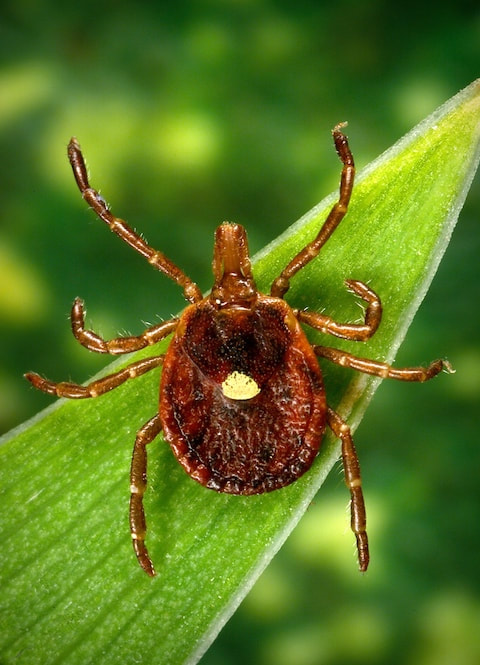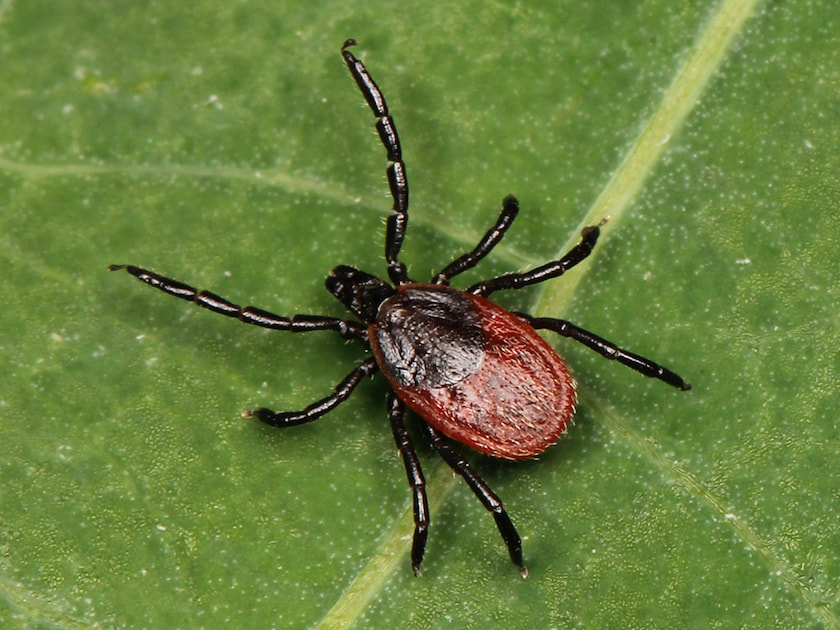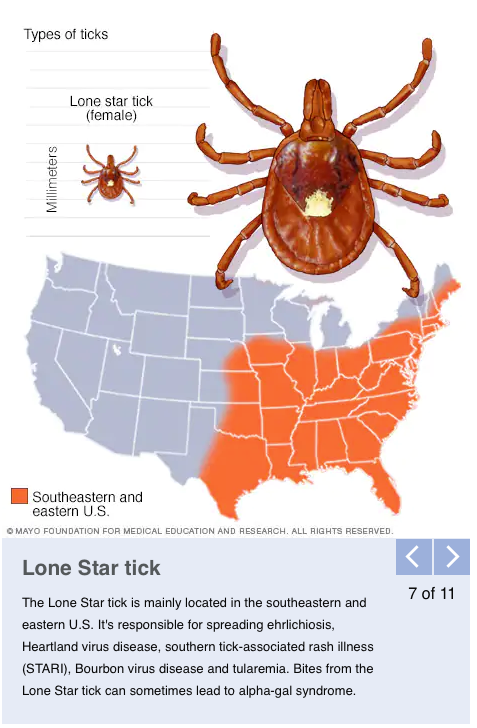Many of us are familiar with the Black Legged Tick (Deer Tick) that causes Lyme disease. Unfortunately, with our warming weather, another tick is working its way north into our territory. The Lone Star Tick has arrived - long time residents recently found one. "Checking for ticks after the hike we noticed a tiny black spot on my leg. We looked at it with the magnifying glass and decided it wasn’t a tick; too small, too dark, no legs. This morning the spot was red and itchy, so I picked off the thing and it was a tick, but not like any we’ve ever seen. Dr. Neemi at SVMC said it probably was a Lone Star Tick (we looked it up; it was)."
Both ticks cause ehrlichiosis and anaplasmosis. These are similar tick-borne illnesses that cause flu-like symptoms, including fever, muscle aches and headache. Signs and symptoms of ehrlichiosis and anaplasmosis usually appear within 14 days after a tick bite.
If treated quickly with appropriate antibiotics, you'll likely recover within a few days. Untreated ehrlichiosis and anaplasmosis can result in serious or life-threatening complications.
Alpha-gal syndrome is a type of food allergy. It makes people allergic to red meat and other products made from mammals. In the United States, the condition usually begins with the bite of the Lone Star tick. The bite transfers a sugar molecule called alpha-gal into the body. In some people, this triggers a reaction from the body's defenses, also called the immune system. It causes mild to severe allergic reactions to red meat, such as beef, pork or lamb. It also can cause reactions to other foods that come from mammals, such as dairy products or gelatin
See more information here:
Ehrlichiosis: https://www.mayoclinic.org/diseases-conditions/ehrlichiosis/symptoms-causes/syc-20372142
Alpha Gal: https://www.mayoclinic.org/diseases-conditions/alpha-gal-syndrome/symptoms-causes/syc-20428608
Lyme Disease: https://www.mayoclinic.org/diseases-conditions/lyme-disease/symptoms-causes/syc-20374651
Both ticks cause ehrlichiosis and anaplasmosis. These are similar tick-borne illnesses that cause flu-like symptoms, including fever, muscle aches and headache. Signs and symptoms of ehrlichiosis and anaplasmosis usually appear within 14 days after a tick bite.
If treated quickly with appropriate antibiotics, you'll likely recover within a few days. Untreated ehrlichiosis and anaplasmosis can result in serious or life-threatening complications.
Alpha-gal syndrome is a type of food allergy. It makes people allergic to red meat and other products made from mammals. In the United States, the condition usually begins with the bite of the Lone Star tick. The bite transfers a sugar molecule called alpha-gal into the body. In some people, this triggers a reaction from the body's defenses, also called the immune system. It causes mild to severe allergic reactions to red meat, such as beef, pork or lamb. It also can cause reactions to other foods that come from mammals, such as dairy products or gelatin
See more information here:
Ehrlichiosis: https://www.mayoclinic.org/diseases-conditions/ehrlichiosis/symptoms-causes/syc-20372142
Alpha Gal: https://www.mayoclinic.org/diseases-conditions/alpha-gal-syndrome/symptoms-causes/syc-20428608
Lyme Disease: https://www.mayoclinic.org/diseases-conditions/lyme-disease/symptoms-causes/syc-20374651
Here you can see the range of the Lone Star tick and how it is right at our border.
EVERY SEASON IS TICK SEASON:
Learn about Ticks in Vermont from the Vermont Health Dept. website
The Vermont Department of Health warns residents to be vigilant against the rise of the deer tick population. Deer ticks are carriers of Lyme disease. The following is a list of precautions to take when heading outdoors:
Learn about Ticks in Vermont from the Vermont Health Dept. website
The Vermont Department of Health warns residents to be vigilant against the rise of the deer tick population. Deer ticks are carriers of Lyme disease. The following is a list of precautions to take when heading outdoors:
- Wear light-colored clothing with tight weave to spot ticks easily.
- Wear enclosed shoes, long pants and long-sleeved shirt.
- Tuck shirt into pants and pants into socks or boots.
- The chemical permethrin kills ticks and can be applied to clothing, but not to exposed skin.
- Check clothes and any exposed skin frequently for ticks while outdoors.
- Stay on cleared, well-traveled trails. Walk in the center of trails. Avoid dense woods and bushy areas.
- Avoid sitting directly on the ground or on stonewalls.
- Wearing gators sprayed with permethrin adds another layer of protection


